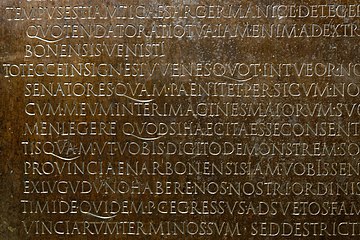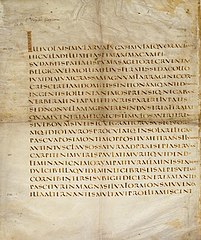Roman square capitals
This article needs additional citations for verification. (February 2014) |
Roman square capitals, also called capitalis monumentalis, inscriptional capitals, elegant capitals and capitalis quadrata, are an
History
Antiquity
Square capitals were used to write
Before the 4th century
Edward Catich is noted for the fullest development of the thesis that the inscribed Roman square capitals owed their form, including the serifs, wholly to the use of the flat brush, rather than to the exigencies of the chisel or other stone cutting tools. Although not universally accepted, the brushed-origin thesis had been proposed in the nineteenth century. Catich made a complete study and proposed a convincing ductus by which the forms were created, using a flat brush and then chisel.[a]
Gallery
-
The SPQR inscriptional capitals on the Arch of Titus, c. AD 81, are an example of inscriptional lettering which would have been infilled with bronze. Note the holes for the "tangs" of the cast bronze letters.
-
Close-up of the Lyon Tablet, a bronze tablet from after AD 48
-
Inscription from the turn of the 2nd and 3rd century AD
-
Folio of the 4th century Vergilius Augusteus with handwritten square capitals
Later influence
Renaissance
Square capitals were greatly respected by artisans of the Renaissance such as Geoffroy Tory and Felice Feliciano.[1][2]
Arts and Crafts movement
In the 19th and 20th centuries, they were a major inspiration for artisans of the Arts and Crafts movement such as Edward Johnston and Eric Gill, and so many signs and engravings created with an intentionally artistic design in the twentieth century are based on them.[3][4][5][6]
Influence on modern typefaces
During the early era of the
See also
Notes
- ^ Edward Catich promulgated his views in two works, Letters Redrawn from the Trajan Inscription in Rome and The Origin of the Serif: Brush Writing and Roman Letters.
- ^ Often referred to simply as "Bringhurst", Robert Bringhurst's Elements is widely respected as the current English-language authority on typographic style.
References
- ^ Warde, Beatrice (1926). "The 'Garamond' Types". The Fleuron: 131–179.
- JSTOR 3253359. Retrieved 17 September 2017.
- ^ Nash, John. "In Defence of the Roman Letter" (PDF). Journal of the Edward Johnston Foundation. Retrieved 13 October 2016.
- ^ Johnston, Edward (1906). Writing & Illuminating & Lettering. Macmillan. pp. 268–269, 384, 391.
The Roman capitals have held the supreme place among letters for readableness and beauty. They are the best forms for the grandest and most important inscriptions.
- ^ Zhukov, Maxim. "The Trajan Letter in Russia and America". Typejournal.ru. Retrieved 4 March 2017.
- ^ Mosley, James (1964). "Trajan Revived". Alphabet. 1: 17–48.
- Bringhurst, Robert (2008), The Elements of Typographic Style(version 3.2). Vancouver: Hartley & Marks.
- ^ Riggs, Tamye (12 June 2014). "The Adobe Originals Silver Anniversary Story: Stone, Slimbach, and Twombly launch the first Originals".




